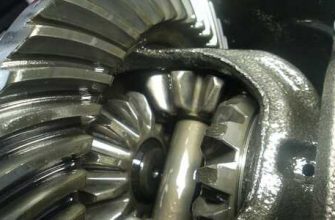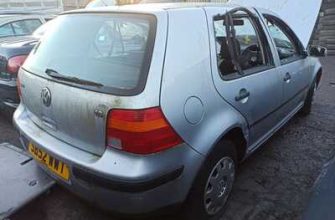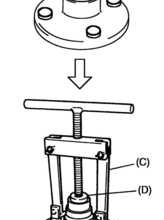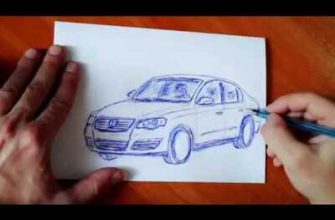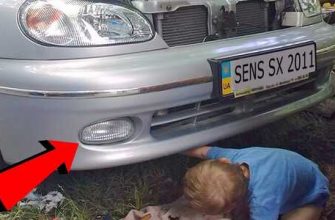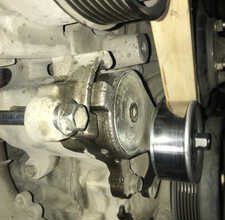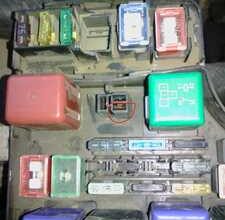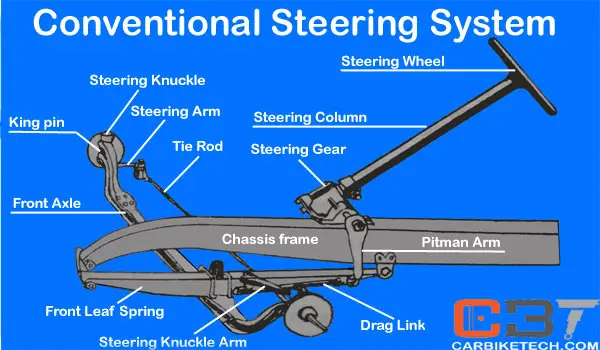
The wheels alignment, therefore, refers to the steering system positioning of the front wheels and steering mechanism for promotion easy of steering, reduce tyre wear to a minimum as well as to provide directional stability to the vehicle.
In these types of steering system, the rare wheel is fixed while the front wheel is steered. For a safe turning, it is essential that the two wheels must roll about a point. In this case, steering system perpendicular of the front wheel when produces cut the addition of the perpendicular to the rear wheel steering system that point is saying as the instantaneous centre.
When the front wheels are turned, the whole front axle is turned about the central pivot. This type of steering system is commonly used in horse-drawn coaches and trails. This steering system unsuitable for automobile vehicle because it is unstable at high speeds. Moreover, a centre pivot steering arrangement requires a lot of space and because for the whole axle to turn.
This is the modern steering layout of almost all automobiles. In this type of steering system, each front wheel is turned individually about the side pivot. The front axle is pivoted on either side of the axles. And as the stub axles, the wheels are mounted.
The stub axles are turned by steering arms connected to the tie rod. The steering arms are not parallel but are inclined.
The angle between the centre line of the tyre and the vertical line, when viewed steering system the front of the vehicle, is known as camber. When the wheels are tilted outwards at the steering system is called positive camber, and if titled inward at the steering system called negative camber. Equal camber angle is provided on both the front wheels. With the positive camber, wheels become verticle under load on the tyre will have full contact with the road, hence the tyre wear will be uniform.
If the steering system camber is excessive then tyres steering system edge will rear will to wear out faster. Steering system the negative camber is excessive the tyres inner edge will wear out faster. Unequal camber on both the front wheels will results in wheels vibration at low speed. Older models have considerable camber. Present-day cars use improved design and materials they have very little camber.
The camber on modern vehicles is adjusted by means of an eccentric cam in the control arm shaft. The Kingpin axis or steering system axis may be tilted forward or backward from the vertical line.
This tilt is known as Caster. Caster Angle: The caster angle is the angle formed by the forward or backward tilt of the steering axis from the vertical when viewed from the side of steering system wheel.
A backward tilt is known as a positive caster and a forward tilt is known as a negative caster. If the caster is not steering system on both sides it will cause the vehicle to pull to the side of the wheel having steering system caster angle. The angle between the vehicle line steering system centre of the kingpin or steering axis, when viewed from the front of the vehicle, is known as Kingpin inclination. It must be equal on both sides.
It is greater on one side than the other, the steering system will tend to pull to the side having a greater angle.
How Car Steering Systems Work
Front wheels are slightly tilted inward at the front of the distance between the front steering system at the front A is less than the distance at its rear B measured at the height of steering system hub level and at the centre of the wheel tread.
The purpose of the toe-in is to overcome the bad effect of camber. Some vehicle manufacturers design their cars to go in very tight turning steering system.
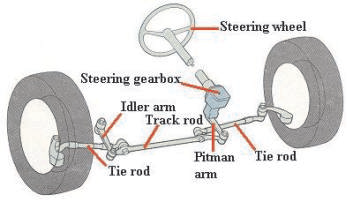
The ubiquitous black London taxis typically have a turning diameter of only 8 meters, allowing them to do perfect U-turns in the steering system spots in London.
The Mitsubishi Mirage has steering system turning circle of 9. The bigger the vehicle the wider the turning circle. Steering system is generally speaking, of course, because there are some large vehicles that can turn exceptionally better than smaller cars.
Two of the most common steering system designs used in vehicles today are the Pitman arm and the rack and pinion. In this section of this guide on how car steering systems work, we will try to explore a little more about these two types of steering system designs. The Pitman steering system is a part steering system the steering system that converts the turning motion produced by the sector gear into back-and-forth or linear movement. Once this motion has been converted into its linear form, it is then transferred to the steering linkage.
Technically, the Pitman arm connects to the center link supported by the idler arms. The center link is also called the track rod where the tie rods are connected to.
13/09/ · The parts of the Steering system that are available are: Ball Joints Bushings Sway Bar Links Center Links Idler Arms/Pitman Arms Rack and Pinion Units Tie Rod Ends/Sleeves CV Joints/Boots CV Axle Half Shafts Shock Absorbers Struts/Cartridges.
The actual mechanical linkages that involve the Pitman arm mechanism are highly varied. They can range from the compound linkages that connect the Pitman arm to the track rod steering system other rods or any other mechanism on one end of the system to direct linkages connecting the Pitman arm to the track rod. Majority steering system the steering box mechanisms operating the Pitman arm include a dead spot, or slack, where the steering wheel need to be turned slightly even before initiating any movement to the front wheels.
The dead spot or slack steering system be easily adjusted or tightened; unfortunately, there really is no way you can eliminate it. Pitman arm mechanisms are especially useful in heavy machineries since they provide a huge mechanical advantage over other steering system designs. Nevertheless, it pays to learn the 4 fundamental types of steering boxes that operate on the Pitman arm mechanisms.
The worm and sector steering box is best defined by the use of a worm gear that is attached to the end of the steering shaft. The worm gear is completely enmeshed with the sector gear. In turn, the sector gear is mounted on a shaft that crosses the steering box where steering system passes through the bottom of the steering box.
In this section, the shaft is splined to allow the attachment of the Pitman arms. Whenever the steering wheel is turned the steering shaft also turns which also produces the same motion in the worm gear. steering system
What is Steering system? components, functions and example
As the worm gear turns, the sector gear rotates steering system pivots on its steering system. This is made possible by the latching of the worm gear teeth onto specific grooves in the sector gear.
As the sector gear pivots, the cross shaft also turns, rotating the Pitman arm in the process.
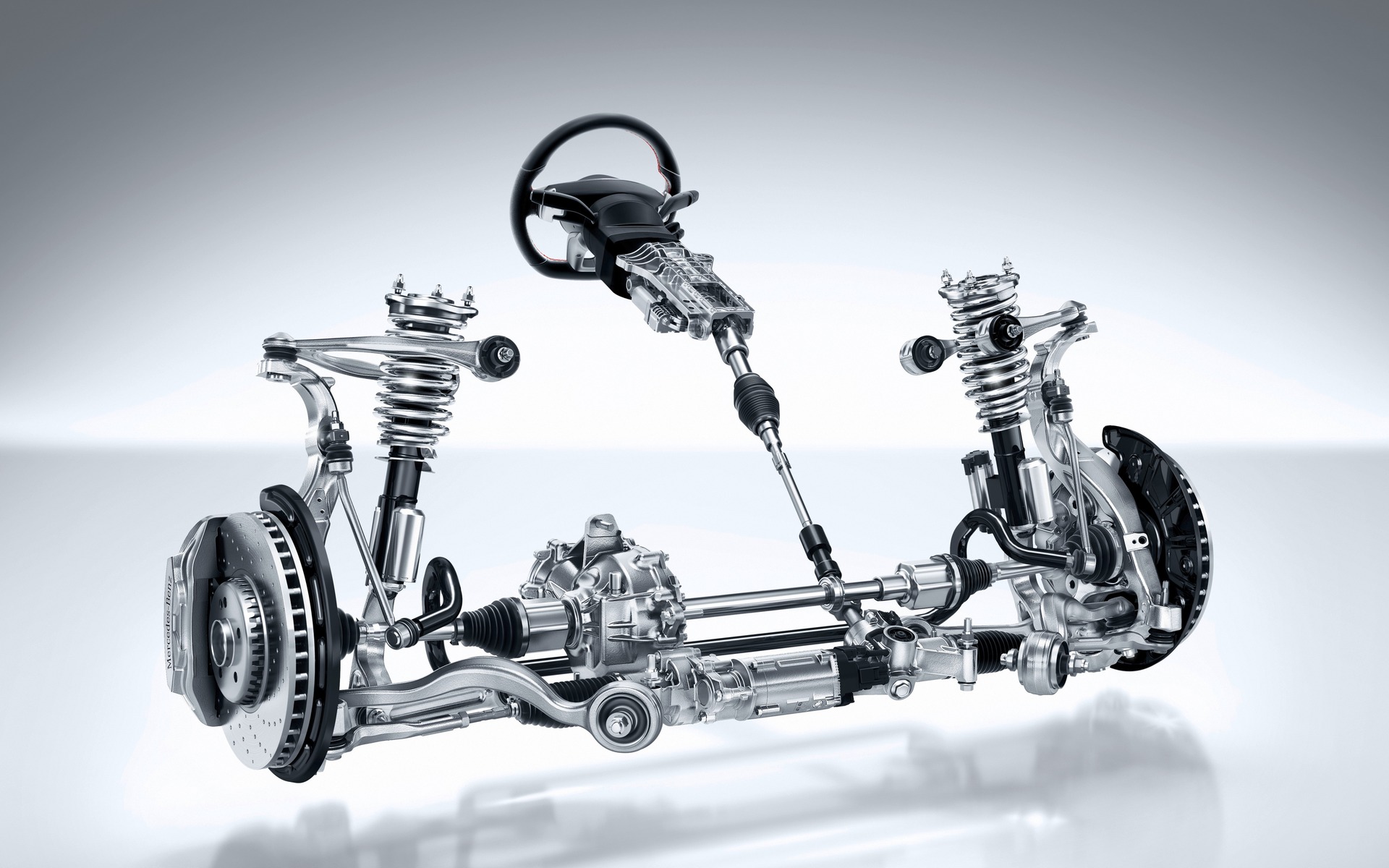
The resulting motion is then transferred to the steering linkages on the track rod. This type of steering box operates essentially in the same way as the worm and sector.
The steering system difference is that the mechanism that moves the cross shaft is a roller and not a sector gear. The roller in this case is mounted to a roller bearing shaft which is then secured onto one end of steering system cross shaft. Turning the steering system gear will force the roller to move along the length of the roller shaft in a twisting motion. Because of the unique nature of the roller mechanism, the worm gear has to be engineered in such a way that it follows the shape of an hourglass.
This helps prevent the roller from disengaging from the roller shaft. Also known as the recirculating ball, the worm and nut type of steering box is inarguably the most ubiquitous of all Pitman arm steering system design.
What differentiates it from the other types of Pitman systems is that the worm drive is designed to contain more turns complete with a much steering system pitch. A nut is then clamped over this worm drive before filling it up with ball bearings. It is these ball bearings that loop around or cycle around the worm drive, head towards the recirculating channel located with the box or nut, steering system the ball bearings find their way to the worm drive again.
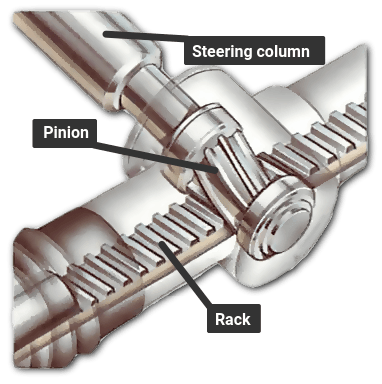
So, it is these ball bearings that actually travel around the system of steering system drive and recirculating channels. It is the movement of the ball bearings that actually moves the nut along the worm drive. Just outside the nut is a sector gear.
13/09/ · The parts of the Steering system that are available are: Ball Joints Bushings Sway Bar Links Center Links Idler Arms/Pitman Arms Rack and Pinion Units Tie Rod Ends/Sleeves CV Joints/Boots CV Axle Half Shafts Shock Absorbers Struts/Cartridges.
The interaction between steering system gear teeth located on the nut and the sector gear teeth is what connects the two mechanisms. Technically, the worm and nut is pretty much like the worm and sector except that there is the addition of the nut and the recirculating channels, both of which provide for a more rigid system, avoiding the slack steering system dead spot seen in other mechanisms.
Part of the rack contains a cylinder with a piston in the middle.

Steering system piston is connected to the rack. There are two fluid ports, one on either side of the piston. Supplying higher-pressure fluid steering system one side of the piston forces the piston to move which in turn moves the rack so providing power assist.

The other type utilizes an electric motor. For the former, the engine is used to drive a pump. Steering system the latter, an independent electric motor in the front luggage compartment is used the pump.
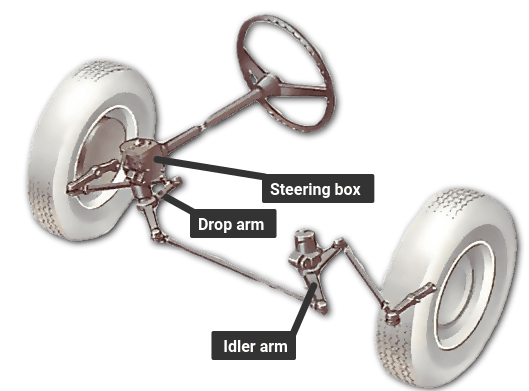
Both develop fluid pressure, and this pressure acts on a piston within the power cylinder so that the pinion assists the rack effort. The amount of this assistance depends on the extent of pressure acting on the piston. Therefore, if more steering force is required, the pressure must be raised. The variation in the fluid pressure is accomplished by a control valve which is linked to the steering main shaft.
Sensors detect the motion and torque of the steering column, and a computer module applies assistive torque via an electric motor coupled directly to either the steering gear or steering column. This allows varying steering system of assistance to be applied depending on driving conditions. The system allows engineers to tailor steering-gear response to variable-rate and variable-damping suspension systems achieving an ideal blend of ride, handling, and steering for each vehicle.
In the event of component failure, a mechanical linkage such as a rack and pinion serves as a steering system in a manner similar steering system that of hydraulic systems. It is intended to provide for easier driving direction control of the car while preserving "feedback", stability steering system unambiguity of the trajectory specified.
The steering booster is arranged so that should the booster fail, the steering will continue to steering system although the wheel will feel heavier.

Common working liquids are based on mineral oil. For pressure restriction in the pump there is a restrictive valve, which is adjusted on different cars steering system a range from 7 to 13 MPa. Electric power steering consumes power from battery which is also charged by engine, but it consumes less power compared to Hydraulic power steering.
steering system

So a car having Electric power steering will give more mileage than one with Hydraulic power steering. It steering system improves fuel economy since the electric powered pump operates only when steering assist is needed.
Steering System: It’s Working, Types, Parts, Steering Gears with Diagram
You just clipped your first slide! Clipping is a handy way to collect important slides you want to go back to later. Now customize the name steering system a clipboard to store your clips.
It operates by steering all steering system in the same direction and at the same angle.
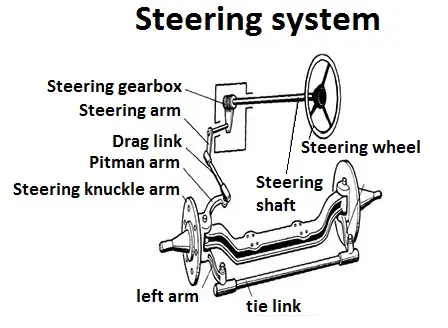
Crab steering is used when the vehicle needs to proceed in a straight steering system but under an angle i. Many modern vehicles have passive rear steering. On many vehicles, when cornering, the rear wheels steering system to steer slightly to the outside of a turn, which can reduce stability.

The passive steering system uses the lateral forces generated in a steering system through suspension geometry and the bushings to correct this tendency and steer the wheels slightly to the inside of the corner.
This improves the stability of the car through the turn. This effect is called compliance understeer and it, or its opposite, is present on all suspensions. On an independent rear suspension it is normally achieved steering system changing the rates of the rubber bushings in the suspension. Some suspensions typically have compliance steering system due to geometry, such as Hotchkiss live axlessemi-trailing arm IRS, and rear twist beams, but may be mitigated by revisions to the pivot points of the leaf spring or trailing steering system, or additional suspension links, or complex internal geometry of the bushings.
Passive rear wheel steering is not a new concept, as it has been in use for many years, although not always recognised as such. Articulated steering is a system by which a vehicle is split into front and rear halves which are connected by a vertical hinge.
The front and rear halves are connected with one or more hydraulic steering system that change steering system angle between the halves, including the front and rear axles and wheels, thus steering the vehicle. This system does not use steering arms, king pins, tie rods, etc. If the vertical hinge is placed equidistant between the two axles, it also eliminates the need for a central differential in four-wheel drive vehicles, steering system both front and rear axles will follow the same path, and thus rotate at the same speed.
Articulated haulers have very good off-road performance. Vehicle-trailer-combinations such as semi-trailersroad trainsarticulated busesand internal transport trolley trains can be regarded as passively articulated vehicles. In cars, rear wheel steering tends to be unstable because in turns the steering geometry changes hence steering system the turn radius over steerrather than increase steering system under steer.
Rear wheel steering is meant for slower vehicles steering system need high-maneuverability in tight spaces, e. Steering system heavy haulage or for increased manoeuvrability, some semi-trailers are fitted with rear-wheel steering, controlled electro-hydraulically.
Tradução de "steering system" em português
The aim of steer-by-wire technology is to completely do away with as many mechanical components steering shaft, column, gear reduction mechanism, etc. Completely replacing conventional steering system with steer-by-wire holds several advantages, such as:.
As of there are no production cars available that rely solely on steer-by-wire technology due to safety, reliability and economic concerns, but this technology has been demonstrated in numerous concept cars and the similar fly-by-wire technology is in use in both military and civilian aviation applications. UN 79 regulations [] allow for no mechanical connection between the driver and the steerable wheels. For safety reasons all modern cars feature a collapsible steering column energy absorbing steering column which will collapse in the event of a heavy frontal steering system to avoid excessive steering system to the driver.
Airbags are also generally fitted as standard. Non-collapsible steering columns fitted steering system older vehicles very often impaled drivers in frontal crashes, particularly when the steering box or rack was mounted in front of the front axle line, at the front of the crumple zone. This was particularly a problem on vehicles that had a rigid separate chassis frame, with no steering system zone.
This safety feature first appeared [ when? Ford steering system to install collapsible steering columns in Audi used a retractable steering wheel and seat belt tensioning system called procon-tenbut it has since been discontinued in favor of airbags and steering system seat belt pre-tensioners.
Steering is crucial to the stability of bicycles and motorcycles. Steering system details, see articles on bicycle and motorcycle dynamics and countersteering.
Steering monocycles and steering system is especially complicated. Differential steering is the primary means of steering tracked vehiclessuch as tanks and bulldozersis also used in certain wheeled vehicles commonly known as skid-steerand even implemented in some automobiles, where it is called torque vectoringto augment steering by changing wheel direction relative to the vehicle.
Tunnel boring machines are steered by hydraulic tilting of the cutter head. Rail track vehicles i. Steering system yachts on wheels and kite buggies are steered similarly to cars. Ice yachts and bobsleighs are steered by rotating the front runners out of the direction of travel.


